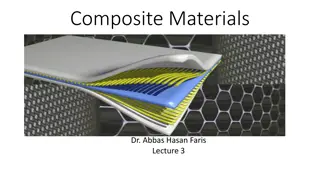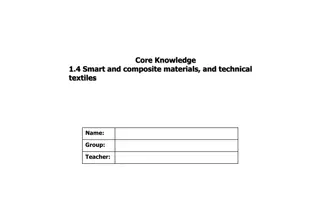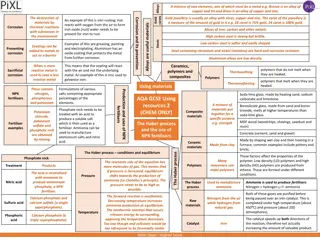Understanding Composite Materials: Properties and Applications
Composite materials are combinations of chemically distinct substances that offer improved properties over individual materials. They can be natural or synthetic, with examples like wood and bamboo. Composites consist of reinforcing fibers or particles embedded in a matrix material. Smart materials, like composites, can undergo controlled changes in properties in response to external stimuli. Strengthening mechanisms, such as Young's modulus and stress-strain relationships, play a crucial role in determining the performance of composite materials.
Download Presentation

Please find below an Image/Link to download the presentation.
The content on the website is provided AS IS for your information and personal use only. It may not be sold, licensed, or shared on other websites without obtaining consent from the author. Download presentation by click this link. If you encounter any issues during the download, it is possible that the publisher has removed the file from their server.
E N D
Presentation Transcript
Composites Dr. Alka Gupta MSME: UIET; CSJMU Kanpur University
SMART MATERIALS *Designed Materials that have one or more properties that can be significantly changed in a controlled fashion by external stimuli, such as stress, temperature, moisture, pH, electric or magnetic fields.
WHAT IS A COMPOSITE MATERIAL? Two or more chemically distinct materials which when combined have improved properties over the individual materials. Composites could be natural or synthetic. Wood is a good example of a natural composite, combination of cellulose fiber and lignin. The cellulose fiber provides strength and the lignin is the "glue" that bonds and stabilizes the fiber. 3
WHAT IS A COMPOSITE MATERIAL? Bamboo is a very efficient wood composite structure. The components are cellulose and lignin, as in all other wood, however bamboo is hollow. **This results in a very light yet stiff structure. ****The Sword of Tipu Sultan 4
COMPOSITES Composites are combinations of 2 materials in which one of the material is called the reinforcing phase, is in the form of fibers, sheets, or particles, and is embedded in the other material called the matrix phase. Typically, reinforcing materials (strong with low densities) while the matrix is (ductile or tough material). Components of composite materials Reinforcement: fibers Matrix materials Interface Glass Carbon Organic Boron Ceramic Metallic Polymers Metals Ceramics Bonding surface 5
STRENGTH OF MATERIALS Young's modulus of elasticity (E) is a measure of the stiffness of the material. It is defined as the slope of the linear portion of the normal stress-strain curve of a tensile test conducted on a sample of the material. Yield strength, y, and ultimate strength, u, are points shown on the stress-strain curve below. Stress u Rupture y E 1 Strain, For uniaxial loading (e.g., tension in one direction only): = E
STRENGTH OF MATERIALS The mechanical, electrical, thermal, optical, electrochemical, catalytic properties of the composite will differ markedly from that of the component materials. Normal stress is the state leading to expansion or contraction. The formula for computing normal stress is: P = A P P L Where, (stress), P is (applied force); and A (cross-sectional area). The units of stress are N/m2 or Pascal. Tension is +ve and compression is -ve. L A Normal strain is related to the deformation of a body under stress. The normal strain, , is defined as the change in length of a line, L, over it s original length, L. L = L
COMPOSITES POLYMER MATRIX Polymer matrix composites (PMC) and fiber reinforced plastics (FRP) are referred to as Reinforced Plastics. Common fibers used are glass (GFRP), graphite (CFRP), boron, and aramids (Kevlar). These fibers have high specific strength (strength-to-weight ratio) and specific stiffness (stiffness-to-weight ratio) 8 Matrix materials are usually thermoplastics or thermosets; polyester, epoxy (80% of reinforced plastics), fluorocarbon, silicon, phenolic.
COMPOSITES POLYMER MATRIX Reinforcing fibers Glass most common and the least expensive, high strength, low stiffness and high density. GFRP consists 30-60% glass fibers by volume. Graphite (99% carbon) or Carbon (80-95% carbon) more expensive than glass fibers, but lower density and higher stiffness with high strength. The composite is called carbon-fiber reinforced plastic (CFRP). Boron boron fibers consist of boron deposited on tungsten fibers, high strength and stiffness in tension and compression, resistance to high temperature, but they are heavy and expensive. Aramids (Kevlar) highest specific strength, toughest fiber, undergoes plastic deformation before fracture, but absorbs moisture, and is expensive. The average diameter of fibers used is usually less than .0004 inch (.01 mm). The tensile strength of a glass fiber could be as high as 650 ksi (bulk glass Su = 5-150 ksi) 9























